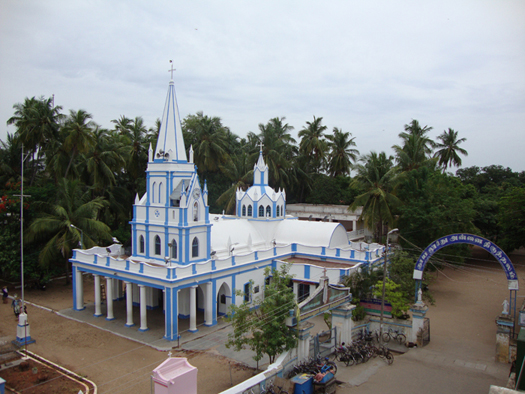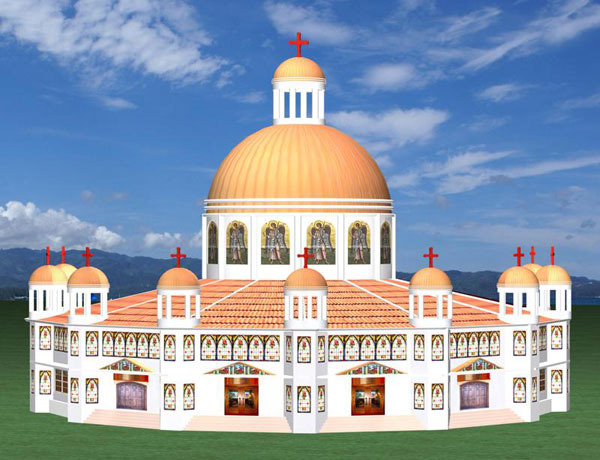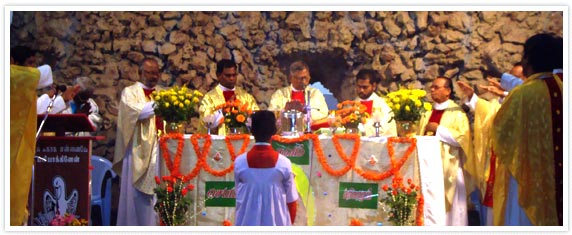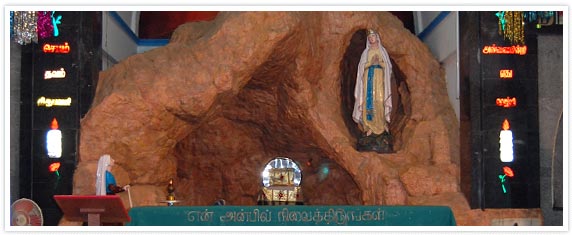SHRINE OF OUR LADY OF LOURDES, Villianur
(DEAR DEVOTEES OF OUR LADY OF VILLIANUR OR VILLIANUR MADHA)
In the whole of Tamilnadu, the ancient place of Our Lady of Lourdes in Villianur. The presence of this Shrine is the pride of the Pondicherry state. The people of Pondicherry have got great affection to this place. This is the centre of religious unity, tolerance, Co- operation and integration. With the social and religious leaders of Villianur, we’re having a “Council for Human rights, Values andrespect” which works for the solidarity among the people of various caste, creed, religious and social states. And the arch-diocese of Pondicherry is proud to have this a shrine in its territory.And we are blessed with this Shrine. Our Ladyeally lives here and protects the people who come here.
We have got at Villianur the three important religious centers, Sutthanpet mosque for Muslims, temple of Shiva for Hindus and Our Lady of Lourdes for Christians. During the feast of each centre all the religious people co- operate without considering their religious differences
So I feel centres like this should be developed in the right manner with due infrastructure for the welfare of the people of this country.
So I invite your suggestions, co-operation and helps to construct this Shrine in the fruitful manner.

Church History:
In 1867, the MEP missionaries of Pondicherry wished to build a Chapel at Villianur which is 13 Kilometers away from Pondicherry on the road to Villupuram. Hence the diocese has bought a piece of land at Villianur and Rev.Fr.Gou on, they procurator of the Pondicherry mission after a long negotiation with the Hindu temple authorities of Thirukameswarer Gogilambigai Temple.started to build a Chapel at Kanuvapet on the outskirts of Villianur, with the amount of the thanksgiving offering of Dr.Lephine’s family for the miraculous cure of his daughter in exchange.
It has taken atleast 10 years to complete the Chapel. And Rev.Fr.Tharbes a cousine brother of Bernadette, the visionary of Lourdes, was appointed as the Parish Priest of Villianur mission. Since he had a direct report of the apparitions of Our Lady of Lourdes And this seems to be the first in the world to be named after Our Lady of Lourdes outsid Lourdes, France. Added to that one pious Lady has paid for a statue of Our Lady of Lourdes and made it come from Lourdes under the direct supervision of Bernadette. It was on the 4th April 1877 the statue arrived at Pondicherry and was taken to the Cathedral after the three dangerous falls of the box containing the Holy Mother’s Statue.
To everybodys amaze, the statue was intact and beautiful. And during the Statue’s stay at the Cathedral, a pious man called Thambusamy Mudaliyar, a native of Kumbakonam who was on his way to Chennai for the surgical intervention for the extra growth of flesh on his left eye, who I has prayed to Our Lady of Lourdes and was cured by a vision of Our Lady of Lourdes during a dream at the same night about 3 am This attracted a lot of crowd to the Cathedral and so the missionaries sent the statue soon to Villianur, on the 7th of April itself.
After some hurdles, Our Lady of Lourdes statue chose her own way to come to Villianur on the 7th April. From that time onwards people in thousands began to flock Villianur to have the vision of this statue and get cured of all their infirmities.
It was in 1885 the arch bishop Laouenan went to Rome and reported the numerous miracles that took place in this Shrine to the Holy Father and got permission on February 21st, 1886 to declare this as an official Shrine of Our Lady of Lourdes, Villianur and to crown the statue in his name.
On his return from Rome, on 8th May 1886 during a grand celebration, witnessed by around 40,000 people during the pontifical high mass the arch bishop crowned the miraculous statue in the name of the pope Leo XIII and declared this church as the Shrine of Our Lady of Lourdes, Villianur and attached permanent plenary indulgences to this shrine.
Sacred Pond
There was a natural pond in front of the chapel. it was once used as the water reservoir for the irrigation of the lands around and water came from the big Oosudu lake which is 10 Kms away from here. And this pond was constructed by Rev.Fr.Lesbond, the Parish Priest, with donations from Zigon Organised by Mr.Lesage. And Mr.Larocgue from the people in Zigon got a statue fro Lourdes and in 1924 and asolemn ceremony took place to install the statue in the middle of the sacred pond after the due consecration of the statue and the pond. Many take this water to their houses to cure their diseases and to have fortune in their lives. And this is the only Catholic church in the whole of Asia having a sacred pond in front of the church. This is one of the added reasons why people flock around this shrine in crowds.
The grotto
19 years after Our Lady’s apparition at Lourdes, the first church and grotto for Our Lady of Lourdes was constructed in 1877. The centenary celebrations was celebrated on September 10th 1977. The procession was the highlight of the celebration. All the credit goes to Rev.Fr.Duissen.He is the one who planned for one big grotto out side the church. The grotto which was inside the church modified according to the instruction of Second Vatican conference. To the remembrance of the centenary celebrations, one big grotto was erected in the garden, which is consecrated by Most. Rev.Seivanather on 10.10.1978.
Important Dates in the Growth of the Shrine
4.4.1877 – The statue of Our Lady is send to Villianur by Bernadette. It shares the importance that it was the first statue that as send to India from Lourdes.
7.4.1877 – The Statue was taken in procession to Villianur from Pondicherry.
8.4.1877 – Mgr.Laouenan blessed the statue and placed it in the grotto.The first church & grotto for Our Lady of Lourdes in ,India was established.
1885 – Mgr.Laouenan went to Rome to say about importance Villianur to the Pope.
21.2.1886 – Pope Leo All granted permission to bless the statue in His name.In Asia only few statues are crowned by Pope. The statue at Villianur is one among them.
8.5.1886 – The statue was crowned, and permanent plenary indulgence attached, declared as Our Lady of Lourd Shrine.
1896 – In Villianur, Novena prayer & car procession were introduced.
1908 – The Golden Jubilee of apparitions of Our Lady of Lourdes was celebrated and a prayer hall constructed in the garden.
1924 – The statue which is in the middle of pond brought from France. Villianur is the only Shrine having pond in front of the church in South India
16.4.1979 – The death anniversary of St.Bemadette was celebrated and a stall was opened after her name.
30.1.1980 – The mysteries of Rosary was painted in front of the grotto III street gate.
11.2.1980 – Villianur Vidrvelli a monthly magazine was published.
30.4.1982 – The grotto inside the chapel remodeled in accordance with the one at Lourdes.
25.12.1983 – Villianur Madha film was produced.
THE CHURCH:
This Church has a significant place in the history of the Catholic Church as the First Church in the World, other than that is in Lourdes – France, to be dedicated to Our Lady of Lourdes.
The devotion to Our Lady of Lourdes in Asia in general and in India in particular has its roots in Villianur.
1866-1877: Rev.Fr. TARBES, M.E.P., the cousin brother of St. Bernadette, constructed the Church.
THE GROTTO
The Grotto, located inside the Church, shares the same privilege with the Church as the First in the world other than that is at Lourdes, France.
THE SACRED POND
The natural ‘Sacred Pond’ which is in front of the Church, depicts the native culture and is unique to Our Shrine.
1924 – A beautiful statue of Our Lady of Lourdes brought from France was erected at the centre of the Sacred Pond.
THE MIRACULOUS STATUE
This miraculous Statue was the workmanship of the same sculptor who sculpted the Statue of Our Lady of Lourdes in the Lourdes Grotto, France.
This Statue was made under the direct supervision of St. Bernadette.
Though the Box containing the miraculous statue (6 Feet tall) had met with three dangerous falls on its way, to everyone’s amaze, it was found intact and beautiful emanating splendid fragrance of rose.
1886: This Statue was crowned by His Holiness Pope Leo XIII and the Church was declared a SHRINE.
PILGRIMAGE ON FOOT
As a sign of gratitude to Our Lady of Villianur, for saving the city from a cyclone, the first pilgrimage on foot (12 Km.) took place on October 10, 1977 from Pondicherry and this beautiful tradition is still continued on the II Saturday in the month of October.
STATIONS OF THE CROSS
2009: The Stations of the Cross were constructed around the ‘Sacred Pond’.
THE PROPOSED NEW CHURCH
As the existing Church could not accommodate the growing number of pilgrims, a new Church is planned with the approval of our Archbishop Most. Rev.Dr.Antony Anandarayar. The construction of the new Church is scheduled to begin at the earliest. Therefore, we solicit your generous contribution.

Kindly send your Donations or Contributions by way of M.O., Cheque, or D.D. drawn in favor of PARISH PRIEST, LOURDES SHRINE, VILLIANUR.
You may directly deposit or wire your contribution to the following bank account:
Syndicate Bank (Villianur Branch) S.B. A/C No: 96032200014209 (Swift Code: SYNBINBBA031).
N.B.: The names of those who donate Rs.50,000/- and more will be engraved in the Church.
INFORMATION TO PILGRIMS:
This Shrine is around 135 years old. During this period, this Shrine has developed slowly in various dimensions. Now a days , it attracts more crowds. The sacred pond attracts more people of various religions. Very specially people go around the pond on their knees and pray for their intensions. They do it for 9 consecutive first Saturdays or ordinary Saturdays. And they feel the power of God working in them and the protection of Our Lady in their lives.

So it is our intention that some sacramental prayer services and Benediction can be arranged eventually around this Sacred Pond. So we have planned a model for the reconstruction of this pond by which people can sit around and the priest can preach and bless the people from the center of the pond. This needs a heavy investment which is worth spending in view of the abundant divine graces and favors which will be procured by the thousands of Indian people.
In this present Indian social situation of religious intolerance, extremism, dissentions and rivalries, this kind of Shrines and its spiritual activities can be a source of unity, religious tolerance and integration in the Indian society.
The second grand project in the future will be a construction of a big Basilica here. In future this Shrine will be gathering enormous crowds of people and the Shrine has to equip itself to accommodate the people. So we need a beautiful Basilica.
Also we are planning to have a home for the old aged and abandoned people. To get alms from the devotees and the pilgrims many abandoned old people come from many places of Tamil Nadu and stay around the shrine in the streets. It is our duty also to take care of them. So the Shrine also wants to construct a home for the aged and abandoned.
APPARITIONS OF OUR LADY AT LOURDES:
The event that attracted the attention of the world in the 19th century was the apparitions of Our Lady at Lourdes, France. These apparitions have taken place in 1858 in between 11th February to 16th July. Mother Mary appeared to a young girl Bernadette 18 times from the grotto called Massabielle and revealed her name as The Immaculate Conception and invited people of all nations to come to Lourdes on pilgrimage.

And Our Lady worked the miracle of the spring which still continues to flow for more than a century and the water of which cures thousands of people suffering from various diseases.
This historical place and the apparitions are the sources of inspiration to our shrine of Our Lady of Villianur. At the resemblance of the sacred spring at Lourdes, our shrine also has got a sacred pond in which we have water all throughout the year. Once in a year when we clean the water and let the fresh water in, we usually make arrangements to bring water from the spring of Lourdes and mingle it here. Lots of people take this water home to use it for the cure of the disease and dispel the evil sprits from the house, fields, work spots, offices and workshops etc.
EDUCATIONAL INSTITUTIONS:
St. Mary’s Cottage (Orphanage) run by the Shrine caters to the education of Orphans, Semi- Orphans, destitute and Poor Students. It is a pathetic situation that there are many children, who have lost one or both of their parents, have no source and encouragement for education. We have to admit the fact that these children, who are neglected at their childhood, become ferocious, and indulge in offensive activities when they grow up.
We aim at modification of their behaviour, all round development of their personality and hope in life. We admit eligible students irrespective of cast, creed and religion. Right now we have 40 students in our Orphanage this year. We take care of all their needs, supply uniforms, writing materials like notebooks, pen, pencil, eraser etc. We are proud to state that many students who studied in this orphanage have secured good jobs and well settled in life. Three students have become priests so far and few work as Teachers in various schools.
MASS TIMINGS
OUR LADY OF LOURDES SHRINE, VILLIANUR, PONDICHERRY, INDIA.
Week Days:
6:00 a.m – Mass
Saturday:
6:00 a.m, 11:30 a.m, 6:00 p.m
I Saturday:
5:30 a.m, 6:45 a.m, 11:30 a.m – Mass
6:00 p.m – Mass & Car Procession
Sunday
6:00 a.m, 7:30 a.m – Mass
5:30 p.m – Mass & Car Procession
FEAST
FLAG HOISTING – The Saturday after Easter Sunday.
FEAST – The 15th day after Easter Sunday i.e. III Sunday of Easter Season.
LITURGICAL TIMINGS
II Saturday in the month of October
2.00 p.m – Pilgrim Walk starts from the Cathedral, Pondicherry.
5.30 p.m – Mass at Villianur.
CONTACT:
SHRINE OF OUR LADY OF LOURDES
CHURCH STREET, VILLIANUR, PONDICHERRY-6050 110, INDIA
Ph : 0413-2666363, Cell : +919443091523
E-mail : frsrichard@yahoo.in , s.richard@sify.com
For more information please visit: http://www.villianurshrine.com/
Follow us: https://www.facebook.com/villianurshrine
Search Keywords: Villianur Madha Shrine Pondicherry, Villianur Madha Shrine Pondy, Shrine Of Our Lady Of Lourdes Villianur, Villianur Madha Church, Villianur Church, Our Lady of Villianur, Villianur Madha, Madha Church Pondicherry, Madha Church Villianur, Roman Catholic Churches in Pondicherry, Catholic Churches in Pondicherry, RC Churches in Pondicherry, Roman Catholic Church in India, Churches in Pondicherry, Villianur Catholic Church, Pondy Church, Catholic Churches in Pondy.